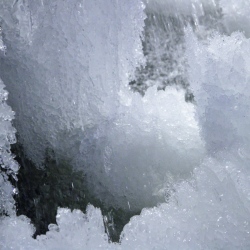
Given its proximity to the Sun, Mercury would seem to be an unlikely place to find ice. But the tilt of Mercury’s rotational axis is almost zero so there are pockets at the poles that never see sunlight. Scientists suggested decades ago that there might be water ice and other frozen volatiles trapped at Mercury’s poles.
The idea received a boost in 1991, when the Arecibo radio telescope in Puerto Rico detected unusually radar-bright patches at Mercury’s poles, spots that reflected radio waves in the way one would expect if there were water ice. Many of these patches corresponded to the location of large impact craters mapped by the Mariner 10 spacecraft in the 1970s. But because Mariner saw less than 50 percent of the planet, planetary scientists lacked a complete diagram of the poles to compare with the images.
MESSENGER’s arrival at Mercury last year changed that. Images from the spacecraft’s Mercury Dual Imaging System taken in 2011 and earlier this year confirmed that radar-bright features at Mercury’s north and south poles are within shadowed regions on Mercury’s surface, findings that are consistent with the water-ice hypothesis.
Now the newest data from MESSENGER strongly indicate that water ice is the major constituent of Mercury’s north polar deposits, that ice is exposed at the surface in the coldest of those deposits, but that the ice is buried beneath an unusually dark material across most of the deposits, areas where temperatures are a bit too warm for ice to be stable at the surface itself.
MESSENGER uses neutron spectroscopy to measure average hydrogen concentrations within Mercury’s radar-bright regions. Water-ice concentrations are derived from the hydrogen measurements. "The neutron data indicate that Mercury’s radar-bright polar deposits contain, on average, a hydrogen-rich layer more than tens of centimeters thick beneath a surficial layer 10 to 20 centimeters thick that is less rich in hydrogen," writes David Lawrence, a MESSENGER Participating Scientist based at The Johns Hopkins University Applied Physics Laboratory and the lead author of one of the papers. "The buried layer has a hydrogen content consistent with nearly pure water ice."
